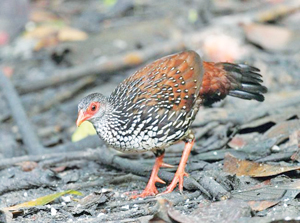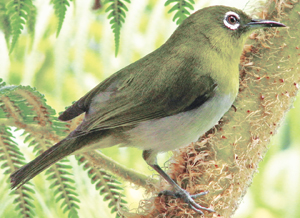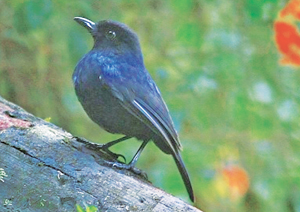Spurfowl
 The Sri Lanka spurfowl (Galloperdix bicalcarata) is a member of the pheasant family which is endemic to the dense rainforests of Sri Lanka. In Sri Lanka, this bird is known as haban kukula in Sinhala. It is a very secretive bird and despite its size is difficult to see as it slips through dense undergrowth. The only indication of its presence is its distinctive ringing call, consisting of a series of three-syllable whistles. Kitulgala and Sinharaja are sites where there is a chance of seeing this bird.
The Sri Lanka spurfowl (Galloperdix bicalcarata) is a member of the pheasant family which is endemic to the dense rainforests of Sri Lanka. In Sri Lanka, this bird is known as haban kukula in Sinhala. It is a very secretive bird and despite its size is difficult to see as it slips through dense undergrowth. The only indication of its presence is its distinctive ringing call, consisting of a series of three-syllable whistles. Kitulgala and Sinharaja are sites where there is a chance of seeing this bird.
This spurfowl is one of three species of bird in the genus Galloperdix. It is a ground nesting bird, which lays 2-5 eggs in a scrape.
Sri Lanka spurfowl is a 37 cm long bird. Both sexes have brown upper parts, wings and tail. The males exhibit vivid crimson red legs and bare facial skin and striking black and white dorsal plumage that extends to its head. There is also extensive white ocellation on the sepia wings and upper back.
The legs of both sexes have multiple metatarsal spurs, which give rise to the specific name. The female has chestnut under parts and a plain brown back and wings. She is more prominently crested than the male.
Sri Lanka spurfowl is a seasonally terrestrial species, like most of its near relatives. It scratches vigorously among the leaf litter of the forest floor for invertebrates, especially mollusks and insects. It will also take various seeds, fallen fruits and spiders.
****
White-eye
The White-eye (Zosterops ceylonensis) is a small passerine bird in the white-eye family. It is a resident breeder in forests, gardens and plantations which is endemic to Sri Lanka, mainly in the highlands.
 This bird is slightly larger than the Oriental white-eye (about 11 cm long) which it replaces above 4000 ft. The upper parts of the body and sides of neck are dark olive green. The rump appears paler green while the crown and forehead appear darker. The wings and tail are brown edged with green on the back. The typical ring of tiny white feathers around the eye is present.
This bird is slightly larger than the Oriental white-eye (about 11 cm long) which it replaces above 4000 ft. The upper parts of the body and sides of neck are dark olive green. The rump appears paler green while the crown and forehead appear darker. The wings and tail are brown edged with green on the back. The typical ring of tiny white feathers around the eye is present.
The lores are dark and there is a dark streak below the eye. The chin, throat and upper breast are greenish-yellow as are the thighs and vent. The belly region is grayish white. The dark bill has a salty base to the lower mandible. The legs are dark. The iris is yellow to reddish brown.
This species can be distinguished from the widespread Oriental white-eye, Zosterops palpebrosus, by its larger size, duller green back and more extensive yellow on the breast. It has a darker patch between the eye and the bill.
It is sociable, forming large flocks which only separate on the approach of the breeding season. It builds a tree nest and lays three unspotted pale blue eggs.
Though mainly insectivorous, the Sri Lankan white-eye will also eat nectar and fruits of various kinds.
The English and scientific names refer to the conspicuous ring of white feathers round the eyes, Zosterops being Greek for girdle-eye.
In Sri Lanka, this bird is known as Lanka Sithasiya in the Sinhala language. This bird appears in a 35 cents Sri Lankan postal stamp first issued in 1983.
****
Whistling thrush
 The Whistling thrush (Myophonus blighi) is a whistling thrush in the family Muscicapidae. It is a resident endemic bird in Sri Lanka.
The Whistling thrush (Myophonus blighi) is a whistling thrush in the family Muscicapidae. It is a resident endemic bird in Sri Lanka.
It is found in the highlands of Sri Lanka in jungles or other dense forest near water. It is omnivorous, eating a wide range of insects, frogs, earthworms and berries. It lays one or two eggs in a neat cup-shaped nest in a bush or on a ledge near water.
It does not form flocks, although several birds may be loosely associated in suitable habitats.
This is a small whistling thrush; at only 20 cm. Adult males are dark blue with a darker head and back. There are bright blue patches on the shoulders, supercilia and forehead. The female is brown above and chestnut below, but has a bright blue shoulder patch like the male.
The male sings its simple whistling song from trees, usually in deep cover.
This is a notoriously difficult species to see, even when the males are singing in the breeding season, which starts in February. It is very shy, scarce, localised and declining due to habitat loss. Perhaps the best chance is at dawn at Horton Plains National Park, 2000m up in the highlands of Sri Lanka.
-Internet
